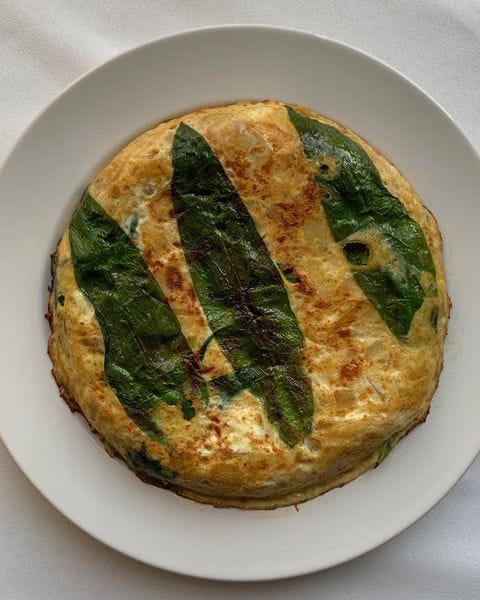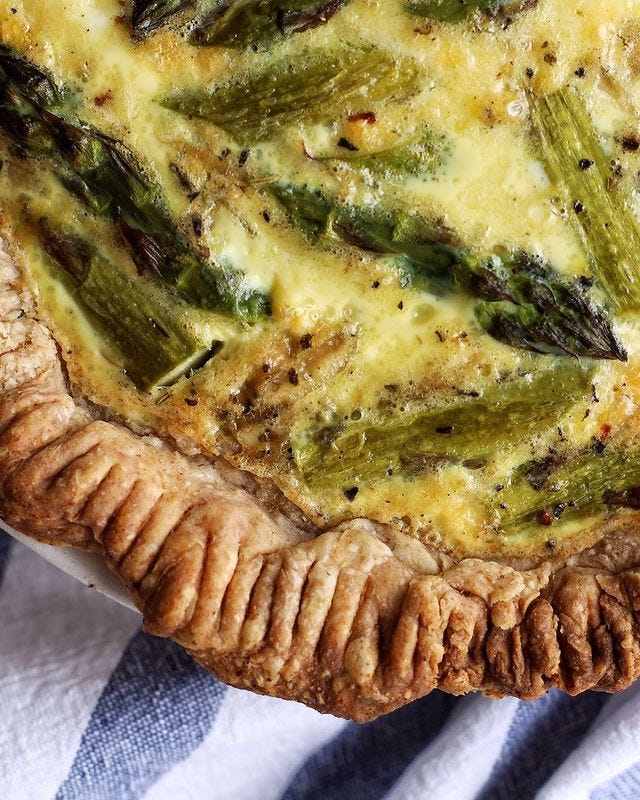Allô! 👋
Hello, and thank you for being here! Welcome (back) to the seasonal sundays section of the good food at home newsletter, where every week we take a closer peek at produce at its peak — with a short introduction, a recipe, and a (sometimes related) cooking Q&A. If you’re a new subscriber and would like to read the previous issues, you can click here to find them!
Right: this week we’re talking eggs. I like to stay positive about things most of the time, but I have to admit, the lack of fresh local produce this time of year is starting to get to me. While social media and my recent trip to Mexico and California remind me that elsewhere, folks are already enjoying all sorts of fresh and juicy produce, here in my part of Norway the hungry gap feels well and truly wide, gaping, and empty.
The thing is, Norwegians don’t really do farmers markets* (though there is an odd-to-me system that involves pre-ordering from food producers via Facebook comments for semi-monthly urban “markets”, but they haven’t opened up for the year yet).
*Bergen does have a famous one right on the downtown docks, but it’s mostly known for tourist-oriented seafood, meat, preserves and pastries, and is only open twice a month in the summer months
Likewise, compared to other countries I’ve lived in and visited, I don’t think Norwegian grocery stores offer as much as they could in terms of quality and diversity. Unless you live in a large city (which I don’t anymore), Norwegian produce pickings appear to be rather slim†, especially at this time of year.
†I have indeed been known to travel all the way into Oslo just to find the most basic of radicchios, though a quick trip across my valley to the nearest “ethnic” grocery store has also saved the day on more than one occasion
That being said, I do love living in Norway for all sorts of other reasons and I still do my best to eat well with good local produce when I can, wherever I am. Even though very few fresh things are locally in season here at the moment, there is still good food to eat. These days, one such item — which happens be to neither preserved, overwintered or stored — is the good old humble egg‡.
‡incidentally, there has been a big dramatic debate about egg shortages in Norway lately, but nonetheless, they do begin their seasonal peak in spring and are still available to most
Much like we are, egg-laying hens are sensitive to light. And, just as we feel energised by the return of longer days in spring, so do they. Give them some warmth and 12+ hours of daylight and their activity soars. While the egg-laying chickens (hens) that most of us source our eggs from are most active between the vernal and autumnal equinoxes, you can of course also source eggs from other birds like geese (dames) and turkeys (hens), who only lay their eggs in spring, typically between March and June§.
§the same is often true for heritage breeds of egg-laying hens, it’s just that we often use artificial light to keep commercial hens producing year-round :(
I can’t speak about eggs and the hens who lay them without mentioning that most eggs sold on this planet come from hens raised in tiny cages. The hens are treated atrociously, the negative environmental and public health impacts are as preventable as they are devastating, and the health benefits of consuming the product of such profit-driven atrocities (vs organic and pasture-raised) seem dubious at best. The only people who truly benefit from such a system appear to be the big owners at the top who never even have to set foot on a farm. Everybody else — the hens, the planet, the farmers, the consumers — seemingly loses.
On the other hand, certified humane and organic farming appears to offer a win-win-win situation to those of us who choose to include eggs in our diets. Better for the animals, for the planet, and for the people — both those who raise the hens and those who eat their eggs. Eggs sold directly by small regenerative farmers (or collected in your own backyard!) should be best, but organic eggs from farmers’ markets, and local food shops are also excellent (eggs-cellent?) choices (and preferable over supermarket organic eggs, which in my opinion are more of a last resort).
•••
I’ve sprinkled in all sorts of egg dishes from Instagram throughout this introduction, all of them savoury, to hopefully provide you with some inspiration for what to do with eggs this spring¶ but, to be honest, a good, fresh, egg is often well-worth eating simply poached or boiled. Its shell should be strong and hard to crack, and its yolk plump and bouncing and richly golden-hued.
To be sure that your eggs are fresh, do try the float test. It’s easy to do and especially useful for certain recipes. Slightly older eggs are good scrambled or in a quiche or omelette, so don’t turn your nose up at them. When it comes to baking, fresher eggs are best for velvety custards, while older ones are better suited to making airy meringues.
This week’s recipe invites you to use eggs as protagonists in your baking. Eggs are of course often used in sweet recipes, but, for the most part, only in a supporting role capacity. This custard-based dessert encourages you to find the best eggs you can and make them the star, worthy of savouring slowly, as part of this simple-yet-exquisite classic.
¶for more ideas and, even better, “eggs-quisite” recipes, I recommend giving ’s Substack and new book, Good Eggs, a lingering look
crème caramel, two ways 🍮
Some recipes for crème caramel will ask that you only use milk, but I think that the “crème” in crème caramel speaks for itself as to why my recipe includes cream too. With regards to eggs, I suggest using whole eggs only if they are very fresh and egg yolks only if they are a little old (mine were somewhere in between). Lastly, I offer two different, but overlapping, flavour profiles below as suggestions for how to perfume your crèmes caramel. You can of course follow these to the letter if you like (I wouldn’t suggest them if I didn’t think they were delicious!), but I also hope that that they’ll inspire you to think outside of the box and put your own twist on things. My only caveat is that I would not recommend altering the inclusion of fresh vanilla — it really is quintessential and, to me, the fragrant little black specks alone effortlessly take a crème caramel to the next level, every time.
•••
INGREDIENTS
Keep reading with a 7-day free trial
Subscribe to good food at home to keep reading this post and get 7 days of free access to the full post archives.













